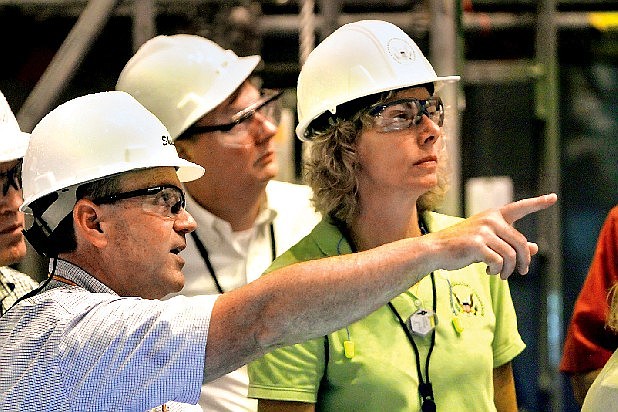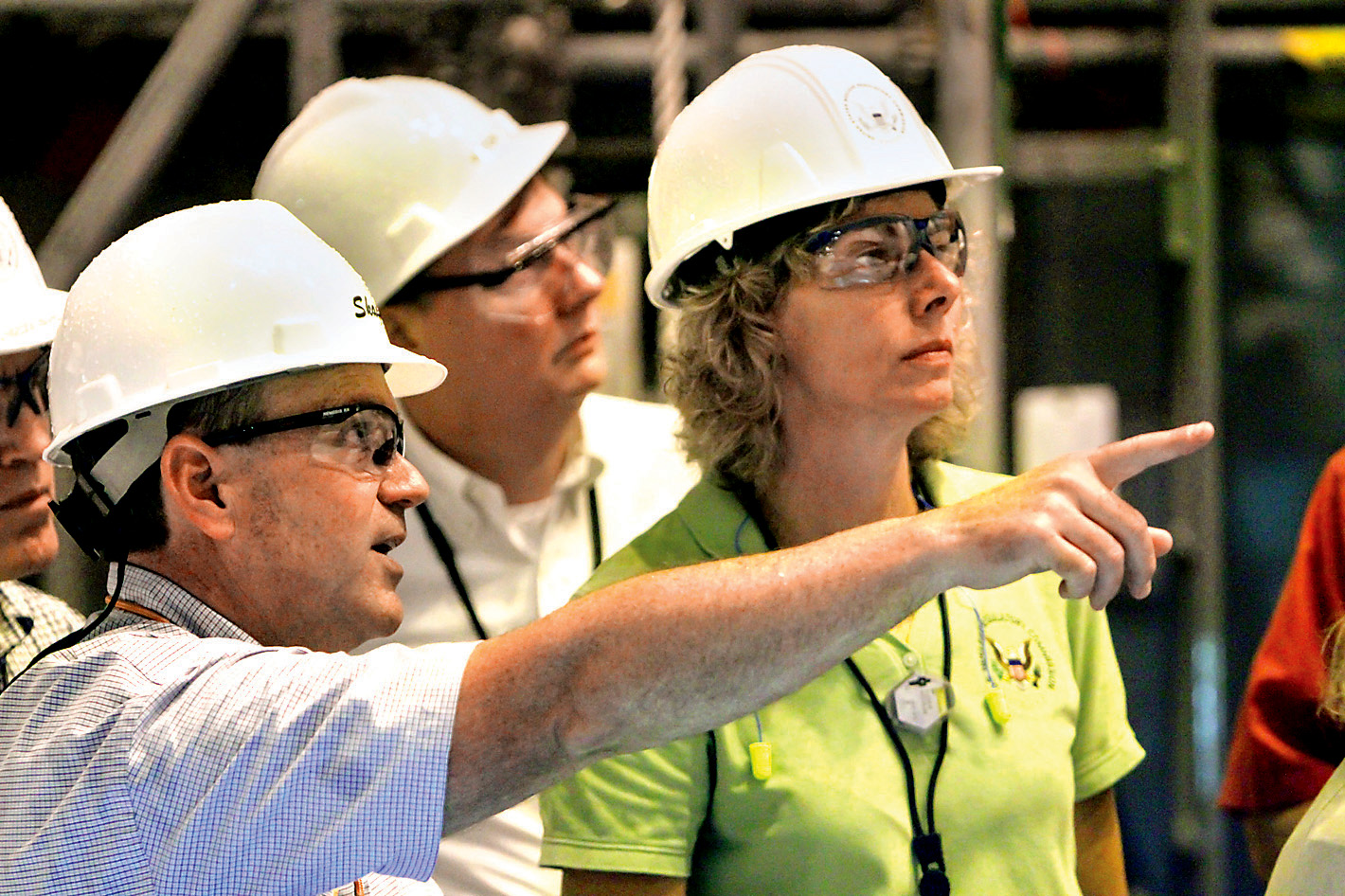NRC chairwoman sees 'no show stoppers' at Watts Bar nuclear plant
Wednesday, June 25, 2014
WATTS BAR AT A GLANCE• Location: 1,700 acre site on the Tennessee River near Spring City, Tenn.• History: Construction began in 1973; work suspended in 1988; and restarted in 2008; Unit 1 started in 1996• Design: Two Westinghouse pressurized water reactors• Power output: Each unit can generate 1,150 megawatts, or enough power for two cities the size of Chattanooga• Staff: 3,200 workers are employed in building the unit 2 reactor• Status: More than 90 percent complete• Next steps: Submit operating license application by year end; Load nuclear fuel next June; power generation by the end of 2015• Investment: Since work was restarted five years ago on the half-finished Unit 2, TVA expects to spend another $4.2 billion to $4.5 billion to complete the reactor.Source: Tennessee Valley Authority
More than four decades after construction began at the Watts Bar Nuclear Plant, nearly 3,200 TVA and contract employees are working around the clock to finish what should be America's first new nuclear reactor of the 21st century.
Despite previous delays and cost overruns, the head of the final $4 billion-plus construction phase for the Unit 2 reactor at Watts Bar said Tuesday the project "is on time and on budget" and should be completed next year.
"We are still moving ahead toward being able to generate power by December 2015," TVA Senior Vice President Mike Skaggs said.
But before nuclear fuel is loaded in a second reactor at Watts Bar, the Tennessee Valley Authority must still gain regulatory approval for an operating license for the Unit 2 reactor.
Nuclear critics vow to try to fight any such license until the Nuclear Regulatory Commission resolves what to do with radioactive nuclear waste and makes sure that the new plant can withstand a disaster like what befell Japan's Fukushima Daiichi nuclear plant when it was hit by an earthquake and tsunami in March 2011.
NRC Chairwoman Allison Macfarlane, who toured Watts Bar on Tuesday, said regulators will present a plan to safely store nuclear wastes by this fall and will make sure TVA is able to comply with post-Fukishima rules for floods and earthquakes at Watts Bar.
"There is a fair amount of work they have to do still and there is a fair amount of work that we will have to do to ensure that the work that they do meets NRC standards," Macfarlane said. "But there's no show-stoppers at this point."
Macfarlane said Watts Bar is ahead of most U.S. nuclear plants in assessing and addressing the flooding, seismic and back-up power weaknesses uncovered from the Fukishima plant meltdown in Japan.
The Fukishima accident showed that what was previously thought of as a robust safety system with multiple backups could break down in the event of multiple problems caused by both earthquakes and floods.
TVA has reassessed the risks of such natural disasters in East Tennessee and is making changes at its dams and nuclear plants in response. Skaggs said Watts Bar has added additional backup power sources, elevated equipment subject to a worst-case floods and installed new flood control measures at four of its dams.
TVA expects to be in full compliance with the new post-Fukishima rules by next year, agency spokesman Scott Brooks said.
"They seem to be on track to get all of these changes done (by next year)," Macfarlane said after meeting with top TVA and NRC officials at Watts Bar.
TVA's critical path toward starting the Watts Bar Unit 2 still requires regulators to also adopt a court-accepted plan for storing or disposing of highly radioactive wastes generated at nuclear plants. Macfarlane said the NRC will present such a plan by this fall ahead of any licensing decision next year for Watts Bar.
The NRC has gathered public comment on nuclear waste alternatives since a court ruled that the agency must have a nuclear waste confidence plan in place before new plants are licensed. The original plan for a nuclear storage repository inside Yucca Mountain in Nevada has been scrapped, at least for now.
The NRC is developing acceptable ways to store radioactive wastes at each nuclear plant until a permanent repository is built. But any NRC waste decision could still be challenged in court, which could push back the start of Watts Bar if the courts determined changes or delays were required for waste storage.
David Lochbaum, senior scientist for Union for Concerned Scientists, said nuclear plants should be required to move most radioactive spent nuclear fuel into dry casks for storage, rather than maintaining the radioactive spent fuel rods in water ponds within the plant.
"Once it gets into dry casks, it's much better for the next 60 years or so, but we need to get it there as quickly as possible," Lochbaum said.
Nuclear power critics said Tuesday they also object to the design of Watts Bar and question whether the plant will adequately meet all of the post-Fukushima rules being developed by the NRC.
Louis Zeller, executive director of the Blue Ridge Environmental Defense League, said TVA hasn't yet verified that Watts Bar meets today's stricter earthquake standards for nuclear plants and Watts Bar's ice condenser design makes it more vulnerable to accidents.
"Ice condenser nuclear reactors have only half the strength of other types of pressurized water reactor containment structures," Zeller said. "And it makes no sense whatsoever to approve an operating license for a nuclear reactor which does not meet the NRC's earthquake standards. For an agency which appears to have trouble walking and chewing gum at the same time, I find it incredible that next year TVA would address Fukushima recommendations while in the middle of its initial powering up of the nuclear chain reaction at Watts Bar 2."
Environmental activist Sandra Kurtz said adding Unit 2 at Watts Bar "means double the danger for flooding, double the chance for earthquake damage, double the daily radiation emissions, double the water use, double the tritium leaks into our drinking water, double the radioactive waste storage, and double the chances for likely accidents.
"Why would we who live nearby want a second Watts Bar reactor using old risky technology when there are safer, healthier, more efficient ways to generate electricity?" Kurtz asked.
But Macfarlane said nuclear plant safety systems "are far more robust" in the wake of Fukishima and regulators continue to carefully monitor and review utility safety systems.
Although Watts Bar was designed in the 1960s and construction began in 1973, control and safety systems have since been started and stopped several times because of changing power needs and safety concerns.
The Unit 2 reactor is a twin to the first reactor that was completed in 1996 and has generally operated with reliable generation for the past two decades.
TVA officials contend that nuclear power from Watts Bar will help meet its goal of providing safe, reliable and affordable power better than other energy sources.
Skaggs said TVA will spend most of the next year carefully testing equipment installed at Watts Bar. In the past month, more than 98 percent of the systems tested performed as expected on the initial test.
"Moving forward, we know we're going to be tested in a lot areas as we try to finish up constuction work and test these systems," Skaggs said. ""We've had a lot of challenges in the past three years, but the team has been able to work together safely and with consistent quality."
Contact Dave Flessner at dflessner@timesfreepress.com or at 757-6340.

